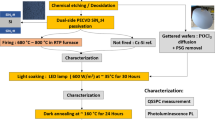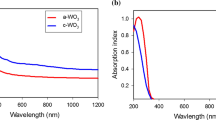Abstract
In this paper, we study the influence of ultrasound (US) on the recovery of light-induced degradation in Cz–Si solar cells. The complete recovery in the dark at near room temperature and the determined value of activation energy (0.656 eV) evidenced the iron–boron pair transformation-related degradation. The ability of extraction of FeB pair’s parameters from short circuit current kinetics was discussed. It was revealed that the US loading leads to the acceleration of the FeB pair association. This effect was investigated for different US frequencies (0.3–30 MHz) and intensities (up to 1.3 W/cm\(^2\)) as well as iron concentrations [(0.2–3) × 10\(^{13}\) cm\(^{-3}\)] in the solar cell over temperature range 300–340 K. It has been found that US longitudinal waves are more efficient than transverse waves. The experimentally observed phenomena are related to the decrease in iron migration energy (up to 10 meV) in the US stress fields.







Similar content being viewed by others
Data availability
Some or all data generated or used during the study are available from the corresponding author by request.
References
S.S. Ostapenko, N.E. Korsunskaya, M.K. Sheinkman, Ultrasound stimulated defect reactions in semiconductors, in Defect Interaction and Clustering in Semiconductors. Solid State Phenomena, vol. 85–86, (Trans Tech Publications, Zürich, 2002), pp. 317–336. https://doi.org/10.4028/www.scientific.net/SSP.85-86.317
R.K. Savkina, Recent progress in semiconductor properties engineering by ultrasonication. Recent Patents Electr. Electron. Eng. 6(3), 157–172 (2013). https://doi.org/10.2174/22131116113066660008
O.Y. Olikh, A.M. Gorb, R.G. Chupryna, O.V. Pristay-Fenenkov, Acousto-defect interaction in irradiated and non-irradiated silicon \(n^+\)–\(p\) structure. J. Appl. Phys. 123(16), 161573 (2018). https://doi.org/10.1063/1.5001123
A. Davletova, S.Z. Karazhanov, Open-circuit voltage decay transient in dislocation-engineered Si p–n junction. J. Phys. D Appl. Phys. 41(16), 165107 (2008). https://doi.org/10.1088/0022-3727/41/16/165107
Y. Olikh, M. Tymochko, O. Olikh, Mechanisms of two-stage conductivity relaxation in CdTe:Cl with ultrasound. J. Electron. Mater. 49(8), 4524–4530 (2020). https://doi.org/10.1007/s11664-020-08179-7
O. Olikh, Reversible influence of ultrasound on \(\gamma -\)irradiated Mo/n-Si Schottky barrier structure. Ultrasonics 56, 545–550 (2015). https://doi.org/10.1016/j.ultras.2014.10.008
O.Y. Olikh, K.V. Voytenko, R.M. Burbelo, Ultrasound influence on I–V–T characteristics of silicon Schottky barrier structure. J. Appl. Phys. 117(4), 044505 (2015). https://doi.org/10.1063/1.4906844
A.V. Sukach, V.V. Teterkin, Ultrasonic treatment-induced modification of the electrical properties of InAs p–n junctions. Tech. Phys. Lett. 35(6), 514–517 (2009). https://doi.org/10.1134/S1063785009060108
D. Krüger, B. Romanyuk, V. Melnik, Y. Olikh, R. Kurps, Influence of in situ ultrasound treatment during ion implantation on amorphization and junction formation in silicon. J. Vac. Sci. Technol. B 20(4), 1448–1451 (2002). https://doi.org/10.1116/1.1493784
B. Romanyuk, V. Melnik, Y. Olikh, V. Popov, D. Krüger, Modification of the Si amorphization process by in situ ultrasonic treatment during ion implantation. Semicond. Sci. Technol. 16(5), 397–401 (2001). https://doi.org/10.1088/0268-1242/16/5/320
S. Kalem, O. Yavuzcetin, C. Altineller, Effect of light exposure and ultrasound on the formation of porous silicon. J. Porous Mater. 7(1), 381–383 (2000). https://doi.org/10.1023/A:1009687021287
S. Fujita, K. Kaneko, T. Ikenoue, T. Kawaharamura, M. Furuta, Ultrasonic-assisted mist chemical vapor deposition of II-oxide and related oxide compounds. Phys. Status Solidi C 11(7–8), 1225–1228 (2014). https://doi.org/10.1002/pssc.201300655
A.A. Istratov, H. Hieslmair, E.R. Weber, Iron and its complexes in silicon. Appl. Phys. A Mater. Sci. Process. 69(1), 13–44 (1999). https://doi.org/10.1007/s003390050968
M.C. Schubert, M. Padilla, B. Michl, L. Mundt, J. Giesecke, J. Hohl-Ebinger, J. Benick, W. Warta, M. Tajima, A. Ogura, Iron related solar cell instability: Imaging analysis and impact on cell performance. Sol. Energy Mater. Sol. Cells 138, 96–101 (2015). https://doi.org/10.1016/j.solmat.2015.03.001
H.S. Laine, V. Vähänissi, A.E. Morishige, J. Hofstetter, A. Haarahiltunen, B. Lai, H. Savin, D.P. Fenning, Impact of iron precipitation on phosphorus-implanted silicon solar cells. IEEE J. Photovolt. 6(5), 1094–1102 (2016). https://doi.org/10.1109/JPHOTOV.2016.2576680
V. Vähänissi, A. Haarahiltunen, H. Talvitie, M. Yli-Koski, H. Savin, Impact of phosphorus gettering parameters and initial iron level on silicon solar cell properties. Prog. Photovolt. Res. Appl. 21(5), 1127–1135 (2013). https://doi.org/10.1002/pip.2215
T. Mchedlidze, C. Möller, K. Lauer, J. Weber, Evolution of iron-containing defects during processing of Si solar cells. J. Appl. Phys. 116(24), 245701 (2014). https://doi.org/10.1063/1.4905027
T. Bartel, F. Gibaja, O. Graf, D. Gross, M. Kaes, M. Heuer, F. Kirscht, C. Möller, K. Lauer, Dynamics of iron-acceptor-pair formation in co-doped silicon. Appl. Phys. Lett. 103(20), 202109 (2013). https://doi.org/10.1063/1.4830227
J. Ajayan, D. Nirmal, P. Mohankumar, M. Saravanan, M. Jagadesh, L. Arivazhagan, A review of photovoltaic performance of organic/inorganic solar cells for future renewable and sustainable energy technologies. Superlattices Microstruct. 143, 106549 (2020). https://doi.org/10.1016/j.spmi.2020.106549
M.A. Green, Photovoltaic technology and visions for the future. Prog. Energy 1(1), 013001 (2019). https://doi.org/10.1088/2516-1083/ab0fa8
S.S. Ostapenko, L. Jastrzebski, J. Lagowski, B. Sopori, Increasing short minority carrier diffusion lengths in solar-grade polycrystalline silicon by ultrasound treatment. Appl. Phys. Lett. 65(12), 1555–1557 (1994). https://doi.org/10.1063/1.112942
S.S. Ostapenko, R.E. Bell, Ultrasound stimulated dissociation of Fe–B pairs in silicon. J. Appl. Phys. 77(10), 5458–5460 (1995). https://doi.org/10.1063/1.359243
A.D. Brailsford, Abrupt-kink model of dislocation motion. Phys. Rev. 122(3), 778–786 (1961). https://doi.org/10.1103/PhysRev.122.778
V.N. Pavlovich, Enhanced diffusion of impurities and defects in crystals in conditions of ultrasonic and radiative excitation of the crystal lattice. Phys. Status Solidi B 180(1), 97–105 (1993). https://doi.org/10.1002/pssb.2221800108
R.M. Peleshchak, O.V. Kuzyk, O.O. Dan’kiv, Formation of periodic structures under the influence of an acousti wave in semiconductors with a two-component defect subsystem. Ukr. J. Phys. 61(8), 741–746 (2016). https://doi.org/10.15407/ujpe61.08.0741
O.Y. Olikh, Acoustically driven degradation in single crystalline silicon solar cell. Superlattices Microstruct. 117, 173–188 (2018). https://doi.org/10.1016/j.spmi.2018.03.027
W. Wijaranakula, The reaction kinetics of iron–boron pair formation and dissociation in p-type silicon. J. Electrochem. Soc. 140(1), 275–281 (1993). https://doi.org/10.1149/1.2056102
C. Möller, T. Bartel, F. Gibaja, K. Lauer, Iron–boron pairing kinetics in illuminated p-type and in boron/phosphorus co-doped n-type silicon. J. Appl. Phys. 116(2), 024503 (2014). https://doi.org/10.1063/1.4889817
J. Tan, D. Macdonald, F. Rougieux, A. Cuevas, Accurate measurement of the formation rate of iron–boron pairs in silicon. Semicond. Sci. Technol. 26(5), 055019 (2011). https://doi.org/10.1088/0268-1242/26/5/055019
D. Macdonald, T. Roth, P.N.K. Deenapanray, K. Bothe, P. Pohl, J. Schmidt, Formation rates of iron-acceptor pairs in crystalline silicon. J. Appl. Phys. 98(8), 083509 (2005). https://doi.org/10.1063/1.2102071
J. Lindroos, H. Savin, Review of light-induced degradation in crystalline silicon solar cells. Sol. Energy Mater. Sol. Cells 147, 115–126 (2016). https://doi.org/10.1016/j.solmat.2015.11.047
A. Schmid, C. Fischer, D. Skorka, A. Herguth, C. Winter, A. Zuschlag, G. Hahn, On the role of AlO\(_x\) thickness in AlO\(_x\)/SiN\(_y\): H layer stacks regarding light- and elevated temperature-induced degradation and hydrogen diffusion in c-Si. IEEE J. Photovolt. 11(4), 967–973 (2021). https://doi.org/10.1109/JPHOTOV.2021.3075850
M. Wagner, F. Wolny, M. Hentsche, A. Krause, L. Sylla, F. Kropfgans, M. Ernst, R. Zierer, P. Bönisch, P. Müller, N. Schmidt, V. Osinniy, H.-P. Hartmann, R. Mehnert, H. Neuhaus, Correlation of the LeTID amplitude to the Aluminium bulk concentration and Oxygen precipitation in PERC solar cells. Sol. Energy Mater. Sol. Cells 187, 176–188 (2018). https://doi.org/10.1016/j.solmat.2018.06.009
D. Chen, M. Kim, B.V. Stefani, B.J. Hallam, M.D. Abbott, C.E. Chan, R. Chen, D.N.R. Payne, N. Nampalli, A. Ciesla, T.H. Fung, K. Kim, S.R. Wenham, Evidence of an identical firing-activated carrier-induced defect in monocrystalline and multicrystalline silicon. Sol. Energy Mater. Sol. Cells 172, 293–300 (2017). https://doi.org/10.1016/j.solmat.2017.08.003
A. Fahrenbruch, R. Bube, Fundamentals of Solar Cells: Photovoltaic Solar Energy Conversion (Academic Press, London, Paris, 1983), p. 580
M. Razeghi, A. Rogalski, Semiconductor ultraviolet detectors. J. Appl. Phys. 79(10), 7433–7473 (1996). https://doi.org/10.1063/1.362677
K. Rajkanan, R. Singh, J. Shewchun, Absorption coefficient of silicon for solar cell calculations. Solid-State Electron. 22(9), 793–795 (1979). https://doi.org/10.1016/0038-1101(79)90128-X
M.A. Green, M.J. Keevers, Optical properties of intrinsic silicon at 300 k. Progr. Photovolt. Res. Appl. 3(3), 189–192 (1995). https://doi.org/10.1002/pip.4670030303
N.I. Klyui, V.P. Kostylyov, A.G. Rozhin, V.I. Gorbulik, V.G. Litovchenko, M.A. Voronkin, N.I. Zaika, Silicon solar cells with antireflecting and protective coatings based on diamond-like carbon and silicon carbide films. Opto-Electr. Rev. 8(4), 402–405 (2000)
V.G. Litovchenko, N.I. Klyui, V.P. Kostylyov, V.I. Gorbulik, Y.P. Piryatinskii, Nitrogen containing diamond-like carbon films as protective and fluorescent layers for silicon solar cells. Opto-Electr. Rev. 8(4), 406–409 (2000)
D.B.M. Klaassen, A unified mobility model for device simulation—I. Model equations and concentration dependence. Solid-State Electron. 35(7), 953–959 (1992). https://doi.org/10.1016/0038-1101(92)90325-7
H.T. Nguyen, S.C. Baker-Finch, D. Macdonald, Temperature dependence of the radiative recombination coefficient in crystalline silicon from spectral photoluminescence. Appl. Phys. Lett. 104(11), 112105 (2014). https://doi.org/10.1063/1.4869295
P.P. Altermatt, J. Schmidt, G. Heiser, A.G. Aberle, Assessment and parameterisation of Coulomb-enhanced Auger recombination coefficients in lowly injected crystalline silicon. J. Appl. Phys. 82(10), 4938–4944 (1997). https://doi.org/10.1063/1.366360
R. Couderc, M. Amara, M. Lemiti, Reassessment of the intrinsic carrier density temperature dependence in crystalline silicon. J. Appl. Phys. 115(9), 093705 (2014). https://doi.org/10.1063/1.4867776
M.A. Green, Intrinsic concentration, effective densities of states, and effective mass in silicon. J. Appl. Phys. 67(6), 2944–2954 (1990). https://doi.org/10.1063/1.345414
F.E. Rougieux, C. Sun, D. Macdonald, Determining the charge states and capture mechanisms of defects in silicon through accurate recombination analyses: a review. Sol. Energy Mater. Sol. Cells 187, 263–272 (2018). https://doi.org/10.1016/j.solmat.2018.07.029
J.D. Murphy, K. Bothe, M. Olmo, V.V. Voronkov, R.J. Falster, The effect of oxide precipitates on minority carrier lifetime in p-type silicon. J. Appl. Phys. 110(5), 053713 (2011). https://doi.org/10.1063/1.3632067
A.W. Mohamed, A.A. Hadi, K.M. Jambi, Novel mutation strategy for enhancing SHADE and LSHADE algorithms for global numerical optimization. Swarm Evol. Comput. 50, 100455 (2019). https://doi.org/10.1016/j.swevo.2018.10.006
G. Zoth, W. Bergholz, A fast, preperetion-free method to detect iron in silicon. J. Appl. Phys. 67(11), 6764–6771 (1990). https://doi.org/10.1063/1.345063
D. Macdonald, A. Cuevas, L.J. Geerligs, Measuring dopant concentrations in compensated p-type crystalline silicon via iron-acceptor pairing. Appl. Phys. Lett. 92(20), 202119 (2008). https://doi.org/10.1063/1.2936840
N. Khelifati, H.S. Laine, V. Vähänissi, H. Savin, F.Z. Bouamama, D. Bouhafs, Dissociation and formation kinetics of iron–boron pairs in silicon after phosphorus implantation gettering. Phys. Status Solidi A 216(17), 1900253 (2019). https://doi.org/10.1002/pssa.201900253
M.J. Aziz, Stress effects on defects and dopant diffusion in Si. Mater. Sci. Semicond. Process. 4(5), 397–403 (2001). https://doi.org/10.1016/S1369-8001(01)00014-2
M. Stavola (ed.), Identification of Defects in Semiconductors (Academic Press, San Diego, 1998)
E.R. Weber, Transition metals in silicon. Appl. Phys. A 30(1), 1–22 (1983). https://doi.org/10.1007/BF00617708
S. Ostapenko, Defect passivation using ultrasound treatment: fundamentals and application. Appl. Phys. A Mater. Sci. Process. 69(2), 225–232 (1999). https://doi.org/10.1007/s003390050994
B.N. Zaveryukhin, N.N. Zaveryukhina, O.M. Tursunkulov, Variation of the reflection coefficient of semiconductors in a wavelength range from 0.2 to 20 \(\mu\)m under the action of ultrasonic waves. Tech. Phys. Lett. 28(9), 752–756 (2002). https://doi.org/10.1134/1.1511774
B. Ziebarth, M. Mrovec, C. Elsässer, P. Gumbsch, Influence of dislocation strain fields on the diffusion of interstitial iron impurities in silicon. Phys. Rev. B 92, 115309 (2015). https://doi.org/10.1103/PhysRevB.92.115309
A.M. Gorb, O.A. Korotchenkov, O.Y. Olikh, A.O. Podolian, R.G. Chupryna, Influence of \(\gamma\)-irradiation and ultrasound treatment on current mechanism in Au–SiO\(_2\)–Si structure. Solid-State Electron. 165, 107712 (2020). https://doi.org/10.1016/j.sse.2019.107712
D. Kropman, V. Seeman, S. Dolgov, A. Medvids, Effect of ultrasonic treatment on the defect structure of the Si–SiO\(_2\) system. Phys. Status Solidi C 13(10–12), 793–797 (2016). https://doi.org/10.1002/pssc.201600052
Funding
This work was supported by National Research Foundation of Ukraine (Project Number 2020.02/0036).
Author information
Authors and Affiliations
Contributions
All authors contributed equally to this work.
Corresponding author
Ethics declarations
Conflict of interest
There are no conflict to declare.
Additional information
Publisher's Note
Springer Nature remains neutral with regard to jurisdictional claims in published maps and institutional affiliations.
Rights and permissions
About this article
Cite this article
Olikh, O., Kostylyov, V., Vlasiuk, V. et al. Intensification of iron–boron complex association in silicon solar cells under acoustic wave action. J Mater Sci: Mater Electron 33, 13133–13142 (2022). https://doi.org/10.1007/s10854-022-08252-3
Received:
Accepted:
Published:
Issue Date:
DOI: https://doi.org/10.1007/s10854-022-08252-3




